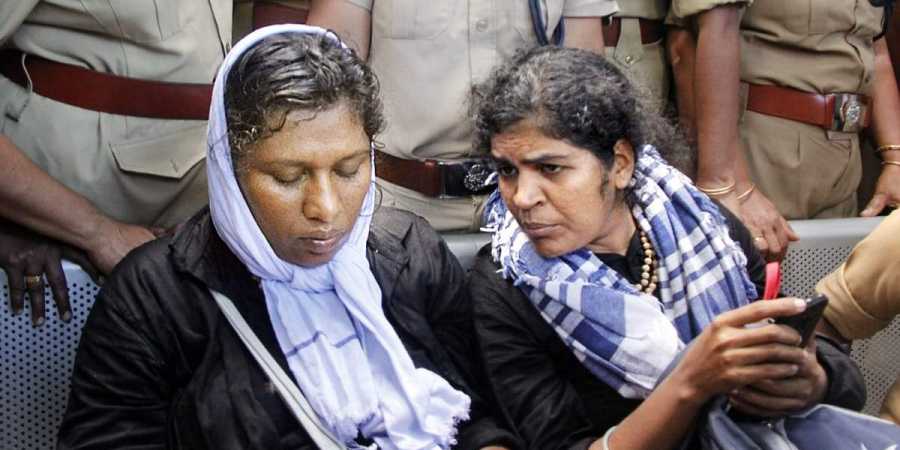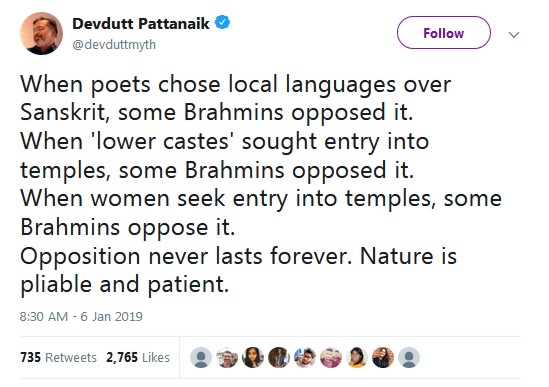Famed mythologist, author and columnist Devdutt Pattanaik was hinting at the larger picture of women’s entry into Sabarimala when he tweeted how opposition and resistance have always failed against nature.

Two women, Bindhu (42) and Kanaka Durga (44), who entered Sabarimala. (Photo | EPS)
Famed mythologist, author and columnist Devdutt Pattanaik was hinting at the larger picture of women’s entry into Sabarimala when he tweeted how opposition and resistance have always failed against nature.
“When poets chose local languages over Sanskrit, some Brahmins opposed it. When ‘lower castes’ sought entry into temples, some Brahmins opposed it. When women seek entry into temples, some Brahmins oppose it. Opposition never lasts forever. Nature is pliable and patient,” he tweeted on Sunday.
When Sant Dnyaneshwar wrote about Bhagwad Gita in Marathi, he faced opposition. His work and contribution to the Bhakti movement through his Varkari movement cannot be denied even today. Abhang’s have become an inseparable part of the larger Marathi culture.
Subaltern women have consistently challenged the Brahmanical caste order. A good example is the resistance of the Channar women to Nair supremacy in south Travancore in the 19th century. Despite horrendous violence by the Nairs against the lower-caste Channar women wearing the upper-cloth, a symbol of caste eminence, women doggedly wore it again and again when they went out. They were attacked repeatedly, brutalized, their homes violated, relatives injured — but they persisted, for almost four long decades. They refused to be satisfied by the demands of respectability which would have been fulfilled by merely wearing a blouse — they were determined to win for themselves the symbol of caste eminence.
Vaikom Satyagraha was a movement against untouchability in the Hindu society that was centred on a temple in Vaikom in 1924-25. The Satyagraha aimed at securing freedom to all sections of society through the public roads leading to the Sri Mahadeva Temple.
It eventually paved the way for the Temple Entry Proclamation, which abolished the ban on the so-called ‘low caste people’ or avarnas from entering Hindu temples.
In May 1936, an All Kerala Temple Entry conference was held near the Trivandrum Central Railway Station. The years of protest culminated in a stunning decision on 12 November 1936 when the young Maharaja declared temples would be opened to all and no Hindu would be barred from worshipping at any temple.
In the historic declaration, the Maharaja Sri Chitra Thirunal Balarama Varma, proclaimed: “Profoundly convinced of the truth and validity of our religion, believing that it is based on divine guidance and on all-comprehending toleration, we have decided, there should henceforth be no restriction placed on any Hindu by birth or religion on entering or worshipping at temples controlled by us and our Government”.
Can anyone erase the temple entry movement by BR Ambedkar from Indian history?
He led the temple entry movement in the year 1930 at Kalaram Temple, Nashik, and Maharashtra for real human rights and political justice. According to him, political power is not the only way to solve all the problems of depressed class people but they should get equal rights in society in every field.
“Is temple entry to be the final goal of the advancement in the social status of the Depressed Classes in the Hindu fold? Or is it only the first step and if it is the first step, what is the ultimate goal? Temple entry as a final goal, the Depressed Classes can never support. Indeed they will not only reject it, but they would then regard themselves rejected by Hindu Society and free to find their own destiny elsewhere. On the other hand, it is only to be the first step they may be inclined to support it,” he had said.
